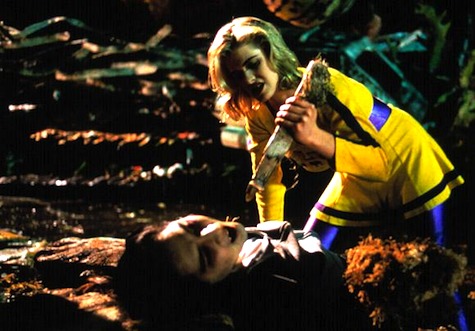It’s been 20 whole years since the world first met a vampire slayer named Buffy. And whatever your first impression was—stop with the leggings already, what was that title about, why is she a cheerleader—it doesn’t matter so much one movie, two television shows, and one comic series later.
But what about the movie? That much-maligned unloved stepchild of an affair? Well, since it’s the 20th anniversary of the film, maybe it’s about time that we re-examine this odd piece.
There’s really no two bones about it: this movie is bad. Sort of fun, but bad. Still, that alone is not unforgivable with the remnants of Joss Whedon’s original script peeking out. Or maybe it’s the entertaining actors in bit parts laced like gold throughout the film. Or both. I could go with both.
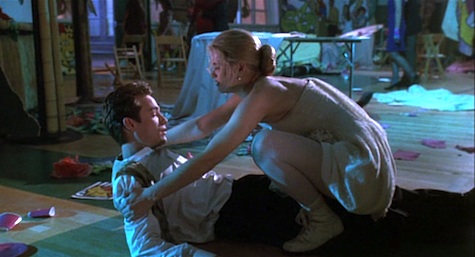
There are all sorts of lenses that one can view this movie through and perhaps that’s part of what makes it so confusing. There’s the Failed Whedon Lens, the Early 90s Lens, the Would-Be Female Empowerment Lens, the Post-Hughes Teen Movie Lens, even the Luke Perry Lens.
And I’ll be honest with you—I’m no Luke Perry fan, but he sort of saves the movie. It probably has a lot to do with him being one of the few characters in the film who comes off as likeable as he was intended to be. He looks like Joss’ personal avatar in this, the one who paves the way for Xander and Wash, and you can’t help but root for the guy. It helps that he’s got a motorcycle, a decent character arc complete with accepting his new girlfriend’s badassery, and knows how to rock his James Dean prom getup.
It’s clear from scene one that one of the film’s biggest blunders is that most of the actors are unsure about how seriously they should be taking the whole project, their leading lady included. I want to like Kristy Swanson, I really do (and she does seem to realize the mantle that she missed out on in retrospect), but she’s just a bit too wink-wink to get me truly invested. She’s playing to the stereotypes rather than ignoring all the obvious cliches you can draw from a valley girl cheerleader. The result means that this Buffy isn’t quite the honest-to-goodness teenager that the movie requires, with all the weighty discovery that would entail. Carter Burwell’s (Velvet Goldmine, No Country For Old Men, In Bruges) soundtrack similarly falls flat, with an overabundance of synth and no real emotional stance on the material.
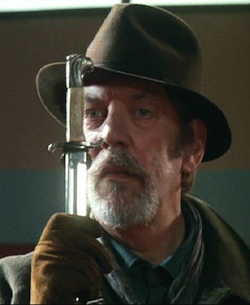
Donald Sutherland was one of the main reasons that Joss Whedon walked away from the set for good, by the creator’s own admission. It’s too bad because while Sutherland is perfectly competent in the role, he’s hardly more than that. Swapping him out for someone who had less disdain for the whole project would have been a smart move. (Were they really counting on him to sell the movie, I wonder?) On the other hand, Paul Reubens and Rutger Hauer can chew scenery to their hearts’ content, and keep everyone coming back for more. Camp aside, Hauer’s villain Lothos, makes even less sense than the Master in Buffy’s initial season—it seems that it took Whedon a while to decide where he wanted to go with this particular brand of vampire, and the result is… all over the place, undoubtedly made worse once the project was out of his hands.
One of the better games to play while watching the film is to imagine these situations for Buffy’s TV incarnation, particularly where her training montages and vapid friends are concerned. Among them is Hilary Swank in her first film role (And who could have possibly guessed that that girl would be a karate kid two years later and an Oscar winner five years after that?) and the group is just as terrifying as anything that Cordelia’s cronies ever turned out. It’s interesting to consider that aspect of Buffy’s life before Sunnydale, the point when she could afford to be more selfish and sheltered. We only get glimpses of that initial revelation and the pain it caused in the show, and while the film is not official canon, it’s easy to re-imagine how it really went down for the Slayer.
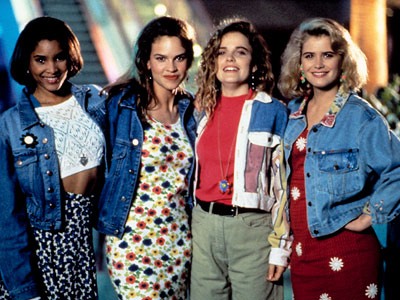
Then there’s that John Hughes lens that I mentioned earlier. This film was released in the wake of Hughes’ famed “brat pack” films, and it shows all the way around. (It’s also post-Lost Boys, which gives the film far fewer excuses where the vampires and their pedigree are involved.) Buffy’s brand of uniqueness is reminiscent of a Hughes hero, from her quips to her fashion sense—admit it, you wanted those boots to go with your prom dress too. Some of it could have been deliberate, but it seems more likely that the film’s director and cast were simply working within a mold that was familiar and comfortable to them. That was how teen movies worked at that point in time. It’s just unfortunate that they kept all of Hughes’ tongue-in-cheek and none of his relevance.
The derision this film garners from Buffy fans is still sort of a shame, though. While it’s kind of them to be so outraged on Joss Whedon’s behalf, the film hardly warrants such anger because it isn’t trying hard enough to warrant much of anything. It’s almost like hearing a new Battlestar Galactica fan rage against the original 70s show (or vice versa): it’s fun to gripe, but ultimately the two are not related because they officially don’t occupy the same universe. Buffy the Vampire Slayer of 1992 just doesn’t quite deserve the pile on that it receives.
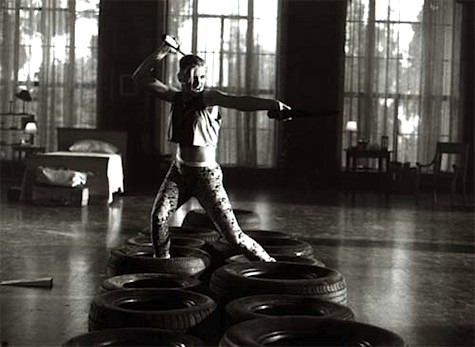
In fact, you could argue instead that it’s sort of wonderful to know this film was the start of so much more. That the mediocre can be pulled out of the trash, dusted off, and given the chance to shine. It’s no must-see, but as a piece of mythology, the Buffy movie is one giant step on a road to greatness. It got our girl in the ring, so to speak. So cheers to this bizarre piece of Slayer history—and a happy 20th birthday. Next year, you can drink.
Emmet Asher-Perrin is pretty sure that 90s fashion contained all the worst elements of 80s fashion and then some. You can bug her on Twitter and read more of her work here and elsewhere.










